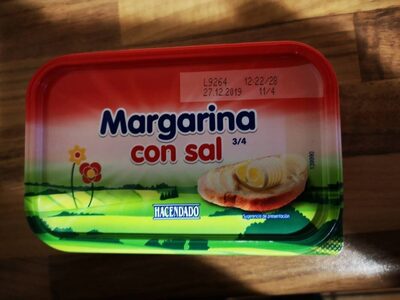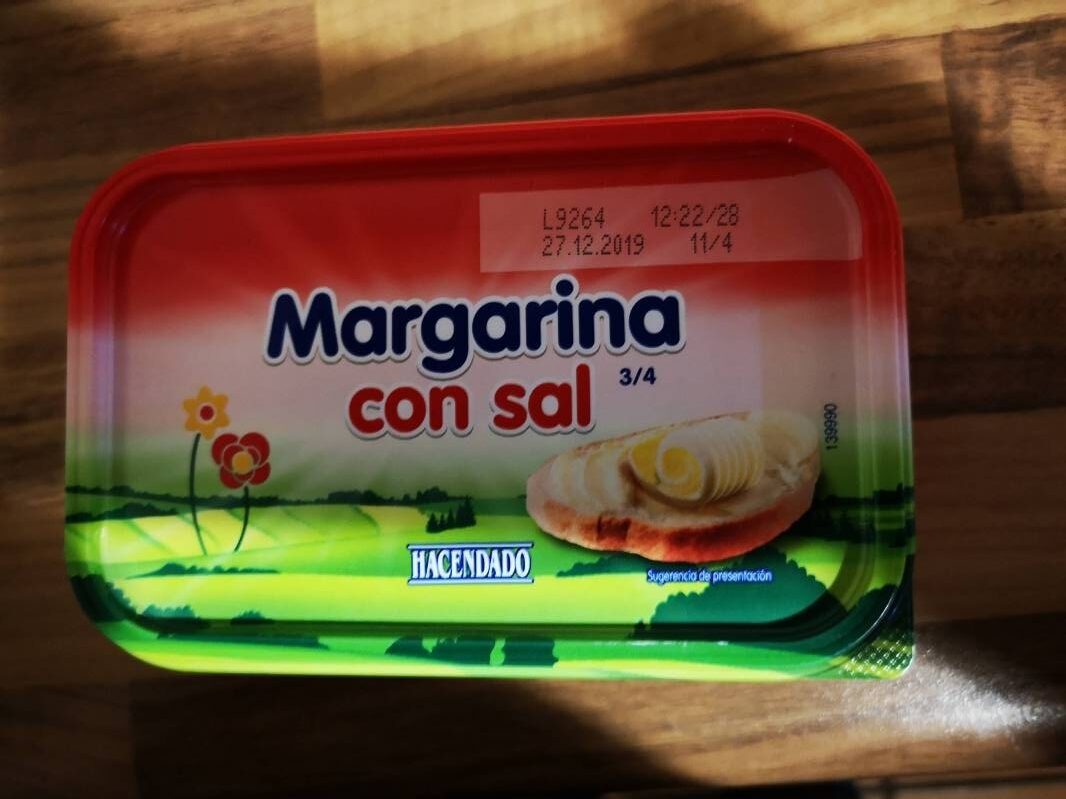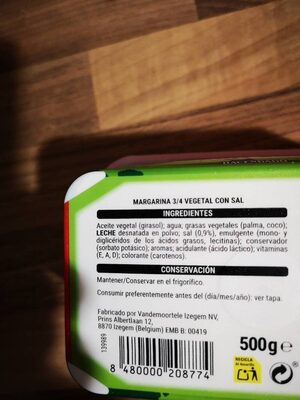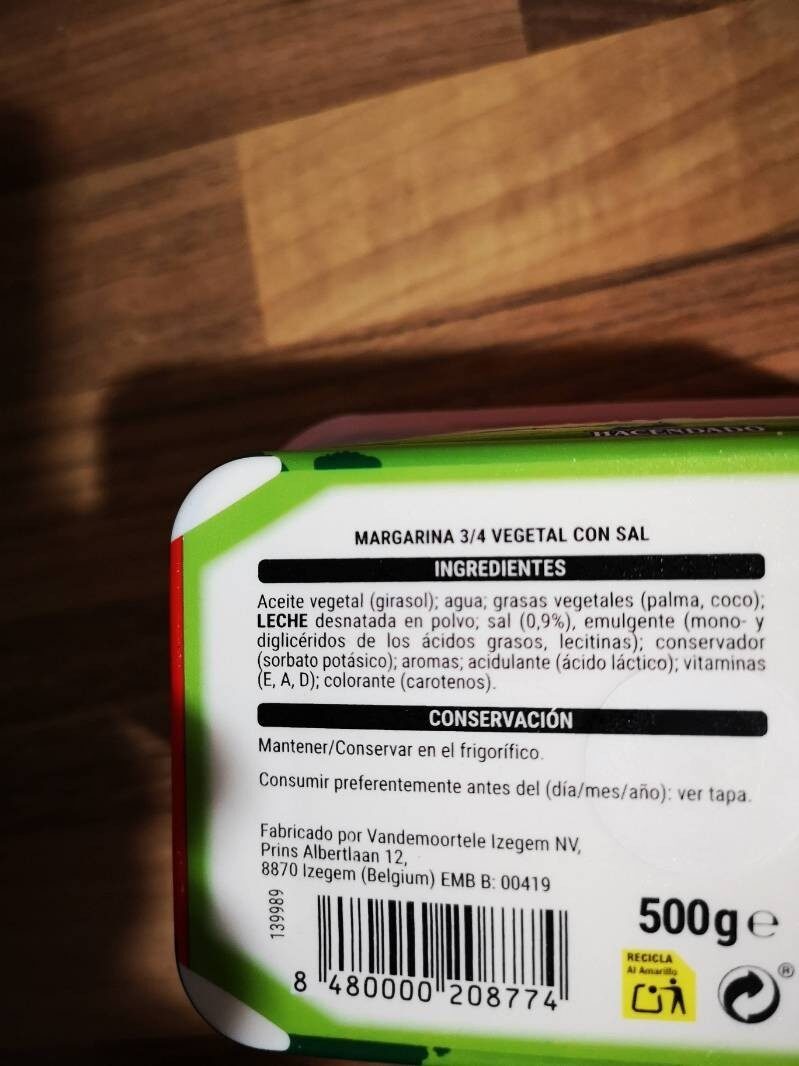Help us make food transparency the norm!
As a non-profit organization, we depend on your donations to continue informing consumers around the world about what they eat.
The food revolution starts with you!
Margarina con sal - Hacendado - 500 g
Margarina con sal - Hacendado - 500 g
This product page is not complete. You can help to complete it by editing it and adding more data from the photos we have, or by taking more photos using the app for Android or iPhone/iPad. Thank you!
×
Barra-kodea: 8480000208774 (EAN / EAN-13)
Kopurua: 500 g
Markak: Hacendado
Kategoriak: en:Plant-based foods and beverages, en:Plant-based foods, en:Fats, en:Spreads, en:Plant-based spreads, en:Spreadable fats, en:Vegetable fats, en:Margarines, en:Aceites y grasas, en:Alimentos de origen vegetal, en:Alimentos y bebidas de origen vegetal, en:Grasas para untar, en:Grasas vegetales, en:Margarinas, en:Margarinas con sal, en:Untables, en:Untables salados, en:Untables vegetales
Etiketak, ziurtagiriak, sariak:
en:Green Dot
Manufacturing or processing places: Vandemoortele Izegem NV, Prins Albertlaan 12, 8870 Izegem (Belgium)
Traceability code: 00419
Saltzen diren herrialdeak: Espainia
Matching with your preferences
Health
Osagaiak
-
19 ingredients
: Aceite vegetal (Girasol), Agua, Grasa vegetal (Palme, Coco), Leche desnatada en polvo, Sal, Emulsionante (Mono - y diglicéridos de ácidos grasos, Lecitinas), Conservante (Sorbato de potasio), Sabores, Acidificante (Ácido láctico), Vitaminas, Tinte (Carotenos)Alergenoak: en:Milk
Food processing
-
Ultra processed foods
Elements that indicate the product is in the 4 - Ultra prozesatutako elikagaiak eta edariak group:
- Gehigarria: E322
- Gehigarria: E471
- Osagaia: Emulsifier
Food products are classified into 4 groups according to their degree of processing:
- Prozesatu gabeko edo ahalik eta gutxien prozesatutako elikagaiak
- Sukaldaritzako osagaiak prozesatu
- Prozesatutako jakiak
- Ultra processed foods
The determination of the group is based on the category of the product and on the ingredients it contains.
Gehigarriak
-
E202
Potassium sorbate: Potassium sorbate is the potassium salt of sorbic acid, chemical formula CH3CH=CH−CH=CH−CO2K. It is a white salt that is very soluble in water -58.2% at 20 °C-. It is primarily used as a food preservative -E number 202-. Potassium sorbate is effective in a variety of applications including food, wine, and personal-care products. While sorbic acid is naturally occurring in some berries, virtually all of the world's production of sorbic acid, from which potassium sorbate is derived, is manufactured synthetically.Source: Wikipedia (Ingeles)
-
E270
Lactic acid: Lactic acid is an organic compound with the formula CH3CH-OH-COOH. In its solid state, it is white and water-soluble. In its liquid state, it is colorless. It is produced both naturally and synthetically. With a hydroxyl group adjacent to the carboxyl group, lactic acid is classified as an alpha-hydroxy acid -AHA-. In the form of its conjugate base called lactate, it plays a role in several biochemical processes. In solution, it can ionize a proton from the carboxyl group, producing the lactate ion CH3CH-OH-CO−2. Compared to acetic acid, its pKa is 1 unit less, meaning lactic acid deprotonates ten times more easily than acetic acid does. This higher acidity is the consequence of the intramolecular hydrogen bonding between the α-hydroxyl and the carboxylate group. Lactic acid is chiral, consisting of two optical isomers. One is known as L--+--lactic acid or -S--lactic acid and the other, its mirror image, is D--−--lactic acid or -R--lactic acid. A mixture of the two in equal amounts is called DL-lactic acid, or racemic lactic acid. Lactic acid is hygroscopic. DL-lactic acid is miscible with water and with ethanol above its melting point which is around 17 or 18 °C. D-lactic acid and L-lactic acid have a higher melting point. In animals, L-lactate is constantly produced from pyruvate via the enzyme lactate dehydrogenase -LDH- in a process of fermentation during normal metabolism and exercise. It does not increase in concentration until the rate of lactate production exceeds the rate of lactate removal, which is governed by a number of factors, including monocarboxylate transporters, concentration and isoform of LDH, and oxidative capacity of tissues. The concentration of blood lactate is usually 1–2 mM at rest, but can rise to over 20 mM during intense exertion and as high as 25 mM afterward. In addition to other biological roles, L-lactic acid is the primary endogenous agonist of hydroxycarboxylic acid receptor 1 -HCA1-, which is a Gi/o-coupled G protein-coupled receptor -GPCR-.In industry, lactic acid fermentation is performed by lactic acid bacteria, which convert simple carbohydrates such as glucose, sucrose, or galactose to lactic acid. These bacteria can also grow in the mouth; the acid they produce is responsible for the tooth decay known as caries. In medicine, lactate is one of the main components of lactated Ringer's solution and Hartmann's solution. These intravenous fluids consist of sodium and potassium cations along with lactate and chloride anions in solution with distilled water, generally in concentrations isotonic with human blood. It is most commonly used for fluid resuscitation after blood loss due to trauma, surgery, or burns.Source: Wikipedia (Ingeles)
-
E322
Lecithin: Lecithin -UK: , US: , from the Greek lekithos, "egg yolk"- is a generic term to designate any group of yellow-brownish fatty substances occurring in animal and plant tissues, which are amphiphilic – they attract both water and fatty substances -and so are both hydrophilic and lipophilic-, and are used for smoothing food textures, dissolving powders -emulsifying-, homogenizing liquid mixtures, and repelling sticking materials.Lecithins are mixtures of glycerophospholipids including phosphatidylcholine, phosphatidylethanolamine, phosphatidylinositol, phosphatidylserine, and phosphatidic acid.Lecithin was first isolated in 1845 by the French chemist and pharmacist Theodore Gobley. In 1850, he named the phosphatidylcholine lécithine. Gobley originally isolated lecithin from egg yolk—λέκιθος lekithos is "egg yolk" in Ancient Greek—and established the complete chemical formula of phosphatidylcholine in 1874; in between, he had demonstrated the presence of lecithin in a variety of biological matters, including venous blood, in human lungs, bile, human brain tissue, fish eggs, fish roe, and chicken and sheep brain. Lecithin can easily be extracted chemically using solvents such as hexane, ethanol, acetone, petroleum ether, benzene, etc., or extraction can be done mechanically. It is usually available from sources such as soybeans, eggs, milk, marine sources, rapeseed, cottonseed, and sunflower. It has low solubility in water, but is an excellent emulsifier. In aqueous solution, its phospholipids can form either liposomes, bilayer sheets, micelles, or lamellar structures, depending on hydration and temperature. This results in a type of surfactant that usually is classified as amphipathic. Lecithin is sold as a food additive and dietary supplement. In cooking, it is sometimes used as an emulsifier and to prevent sticking, for example in nonstick cooking spray.Source: Wikipedia (Ingeles)
-
E471
Mono- and diglycerides of fatty acids: Mono- and diglycerides of fatty acids -E471- refers to a food additive composed of diglycerides and monoglycerides which is used as an emulsifier. This mixture is also sometimes referred to as partial glycerides.Source: Wikipedia (Ingeles)
Ingredients analysis
-
en:May contain palm oil
Ingredients that may contain palm oil: E471, Karoteno
-
en:Non-vegan
Non-vegan ingredients: en:Skimmed milk powderSome ingredients could not be recognized.
We need your help!
You can help us recognize more ingredients and better analyze the list of ingredients for this product and others:
- Edit this product page to correct spelling mistakes in the ingredients list, and/or to remove ingredients in other languages and sentences that are not related to the ingredients.
- Add new entries, synonyms or translations to our multilingual lists of ingredients, ingredient processing methods, and labels.
If you would like to help, join the #ingredients channel on our Slack discussion space and/or learn about ingredients analysis on our wiki. Thank you!
-
en:Vegetarian status unknown
Unrecognized ingredients: es:palme, es:sabores, es:tinteSome ingredients could not be recognized.
We need your help!
You can help us recognize more ingredients and better analyze the list of ingredients for this product and others:
- Edit this product page to correct spelling mistakes in the ingredients list, and/or to remove ingredients in other languages and sentences that are not related to the ingredients.
- Add new entries, synonyms or translations to our multilingual lists of ingredients, ingredient processing methods, and labels.
If you would like to help, join the #ingredients channel on our Slack discussion space and/or learn about ingredients analysis on our wiki. Thank you!
-
Details of the analysis of the ingredients
We need your help!
Some ingredients could not be recognized.
We need your help!
You can help us recognize more ingredients and better analyze the list of ingredients for this product and others:
- Edit this product page to correct spelling mistakes in the ingredients list, and/or to remove ingredients in other languages and sentences that are not related to the ingredients.
- Add new entries, synonyms or translations to our multilingual lists of ingredients, ingredient processing methods, and labels.
If you would like to help, join the #ingredients channel on our Slack discussion space and/or learn about ingredients analysis on our wiki. Thank you!
: Aceite vegetal (Girasol), Agua, Grasa vegetal (Palme, Coco), Leche desnatada en polvo, Sal, Emulsionante (mono- y diglicéridos de ácidos grasos, Lecitinas), Conservante (Sorbato de potasio), Sabores, Acidificante (Ácido láctico), Vitaminas, Tinte (Carotenos)- Aceite vegetal -> en:vegetable-oil - vegan: yes - vegetarian: yes - from_palm_oil: maybe - percent_min: 9.09090909090909 - percent_max: 100
- Girasol -> en:sunflower - vegan: yes - vegetarian: yes - percent_min: 9.09090909090909 - percent_max: 100
- Agua -> en:water - vegan: yes - vegetarian: yes - ciqual_food_code: 18066 - percent_min: 0 - percent_max: 50
- Grasa vegetal -> en:vegetable-fat - vegan: yes - vegetarian: yes - from_palm_oil: maybe - percent_min: 0 - percent_max: 33.3333333333333
- Palme -> es:palme - percent_min: 0 - percent_max: 33.3333333333333
- Coco -> en:coconut - vegan: yes - vegetarian: yes - ciqual_proxy_food_code: 15006 - percent_min: 0 - percent_max: 16.6666666666667
- Leche desnatada en polvo -> en:skimmed-milk-powder - vegan: no - vegetarian: yes - ciqual_food_code: 19054 - percent_min: 0 - percent_max: 25
- Sal -> en:salt - vegan: yes - vegetarian: yes - ciqual_food_code: 11058 - percent_min: 0 - percent_max: 0.9
- Emulsionante -> en:emulsifier - percent_min: 0 - percent_max: 0.9
- mono- y diglicéridos de ácidos grasos -> en:e471 - vegan: maybe - vegetarian: maybe - from_palm_oil: maybe - percent_min: 0 - percent_max: 0.9
- Lecitinas -> en:e322 - vegan: maybe - vegetarian: maybe - percent_min: 0 - percent_max: 0.45
- Conservante -> en:preservative - percent_min: 0 - percent_max: 0.9
- Sorbato de potasio -> en:e202 - vegan: yes - vegetarian: yes - percent_min: 0 - percent_max: 0.9
- Sabores -> es:sabores - percent_min: 0 - percent_max: 0.9
- Acidificante -> en:acid - percent_min: 0 - percent_max: 0.9
- Ácido láctico -> en:e270 - vegan: yes - vegetarian: yes - percent_min: 0 - percent_max: 0.9
- Vitaminas -> en:vitamins - vegan: yes - vegetarian: yes - percent_min: 0 - percent_max: 0.9
- Tinte -> es:tinte - percent_min: 0 - percent_max: 0.9
- Carotenos -> en:e160a - vegan: maybe - vegetarian: maybe - from_palm_oil: maybe - percent_min: 0 - percent_max: 0.9
Elikadura
-
Poor nutritional quality
⚠ ️Warning: the amount of fruits, vegetables and nuts is not specified on the label, it was estimated from the list of ingredients: 5This product is not considered a beverage for the calculation of the Nutri-Score.
The product is in the fats category, the points for saturated fat are replaced by the points for the saturated fat / fat ratio.
Positive points: 0
- Proteinak: 0 / 5 (balioa: 0.5, rounded value: 0.5)
- Fiber: 0 / 5 (balioa: 0, rounded value: 0)
- Fruits, vegetables, nuts, and colza/walnut/olive oils: 0 / 5 (balioa: 5.68181818181818, rounded value: 5.7)
Negative points: 13
- Energia: 6 / 10 (balioa: 2272, rounded value: 2272)
- Azukreak: 0 / 10 (balioa: 0.5, rounded value: 0.5)
- Saturated fat / fat ratio: 4 / 10 (balioa: 28.3333333333333, rounded value: 28.3)
- Sodioa: 3 / 10 (balioa: 360, rounded value: 360)
The points for proteins are not counted because the negative points are greater or equal to 11.
Nutritional score: (13 - 0)
Nutri-Score:
-
Nutrient levels
-
Koipe in high quantity (60%)
What you need to know- A high consumption of fat, especially saturated fats, can raise cholesterol, which increases the risk of heart diseases.
Recommendation: Limit the consumption of fat and saturated fat- Choose products with lower fat and saturated fat content.
-
Gantz-azido ase in high quantity (17%)
What you need to know- A high consumption of fat, especially saturated fats, can raise cholesterol, which increases the risk of heart diseases.
Recommendation: Limit the consumption of fat and saturated fat- Choose products with lower fat and saturated fat content.
-
Azukre in low quantity (0.5%)
What you need to know- A high consumption of sugar can cause weight gain and tooth decay. It also augments the risk of type 2 diabetes and cardio-vascular diseases.
Recommendation: Limit the consumption of sugar and sugary drinks- Sugary drinks (such as sodas, fruit beverages, and fruit juices and nectars) should be limited as much as possible (no more than 1 glass a day).
- Choose products with lower sugar content and reduce the consumption of products with added sugars.
-
Gatz arrunt in moderate quantity (0.9%)
What you need to know- A high consumption of salt (or sodium) can cause raised blood pressure, which can increase the risk of heart disease and stroke.
- Many people who have high blood pressure do not know it, as there are often no symptoms.
- Most people consume too much salt (on average 9 to 12 grams per day), around twice the recommended maximum level of intake.
Recommendation: Limit the consumption of salt and salted food- Reduce the quantity of salt used when cooking, and don't salt again at the table.
- Limit the consumption of salty snacks and choose products with lower salt content.
-
-
Nutrition facts
Nutrition facts As sold
for 100 g / 100 mlAs sold
per serving (100g)Compared to: en:margarinas Energia 2.272 kj
(543 kcal)2.270 kj
(543 kcal)+% 3 Koipe 60 g 60 g +% 2 Gantz-azido ase 17 g 17 g -% 12 Carbohydrates 0,5 g 0,5 g +% 53 Azukre 0,5 g 0,5 g +% 53 Fiber 0 g 0 g Proteina 0,5 g 0,5 g +% 67 Gatz arrunt 0,9 g 0,9 g +% 84 Alkohol 0 % vol 0 % vol A bitamina 760 µg 760 µg D bitamina 5,9 µg 5,9 µg Vitamin E 23 mg 23 mg Fruits‚ vegetables‚ nuts and rapeseed‚ walnut and olive oils (estimate from ingredients list analysis) 5,682 % 5,682 %
Ingurumena
-
Eco-Score C - Moderate environmental impact
The Eco-Score is an experimental score that summarizes the environmental impacts of food products.→ The Eco-Score was initially developped for France and it is being extended to other European countries. The Eco-Score formula is subject to change as it is regularly improved to make it more precise and better suited to each country.Life cycle analysis
-
Average impact of products of the same category: B (Score: 75/100)
Kategoria: Vegetable fat (margarine type), spreadable, 50-63% fat, light, unsalted, rich in omega 3
Kategoria: Vegetable fat (margarine type), spreadable, 50-63% fat, light, unsalted, rich in omega 3
- PEF environmental score: 0.31 (the lower the score, the lower the impact)
- including impact on climate change: 2.11 kg CO2 eq/kg of product
Stage Impact Agriculture
72.7 %Processing
9.4 %Ontziratzea
4.9 %Transportation
9.1 %Distribution
3.0 %Consumption
0.8 %
Bonuses and maluses
-
Missing origins of ingredients information
Malus: -5
⚠ ️ The origins of the ingredients of this product are not indicated.
If they are indicated on the packaging, you can modify the product sheet and add them.
If you are the manufacturer of this product, you can send us the information with our free platform for producers.
-
Missing packaging information for this product
Malus: -15
⚠ ️ The information about the packaging of this product is not filled in.⚠ ️ For a more precise calculation of the Eco-Score, you can modify the product page and add them.
If you are the manufacturer of this product, you can send us the information with our free platform for producers.
Eco-Score for this product
-
Impact for this product: C (Score: 55/100)
Produktua: Margarina con sal - Hacendado - 500 g
Life cycle analysis score: 75
Sum of bonuses and maluses: -20
Final score: 55/100
-
Carbon footprint
-
Equal to driving 1.1 km in a petrol car
211 g CO² per 100g of product
The carbon emission figure comes from ADEME's Agribalyse database, for the category: Vegetable fat (margarine type), spreadable, 50-63% fat, light, unsalted, rich in omega 3 (Source: ADEME Agribalyse Database)
Stage Impact Agriculture
64.1 %Processing
10.0 %Ontziratzea
8.5 %Transportation
15.3 %Distribution
1.8 %Consumption
0.3 %
Ontziratzea
-
Missing packaging information for this product
⚠ ️ The information about the packaging of this product is not filled in.Take a photo of the recycling information Take a photo of the recycling information
Transportation
-
Origins of ingredients
Missing origins of ingredients information
⚠ ️ The origins of the ingredients of this product are not indicated.
If they are indicated on the packaging, you can modify the product sheet and add them.
If you are the manufacturer of this product, you can send us the information with our free platform for producers.Add the origins of ingredients for this product Add the origins of ingredients for this product
Report a problem
-
Incomplete or incorrect information?
Category, labels, ingredients, allergens, nutritional information, photos etc.
If the information does not match the information on the packaging, please complete or correct it. Open Food Facts is a collaborative database, and every contribution is useful for all.
Datuen iturria
Product added on by elcoco
Last edit of product page on by ayecptn.
Produktuaren orria -gatik editatua acuario, elcoco.f6d8930e3886d2c1cad5238fe783e932, fabi2, grumpf, inf, kiliweb, musarana, openfoodfacts-contributors, quingra, roboto-app, yuka.VzcxZExiWXVwTndBdFBZRTVqZm93Y2x2NHFLa1JtM3FKZFpKSUE9PQ.











